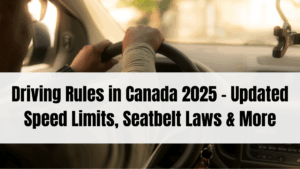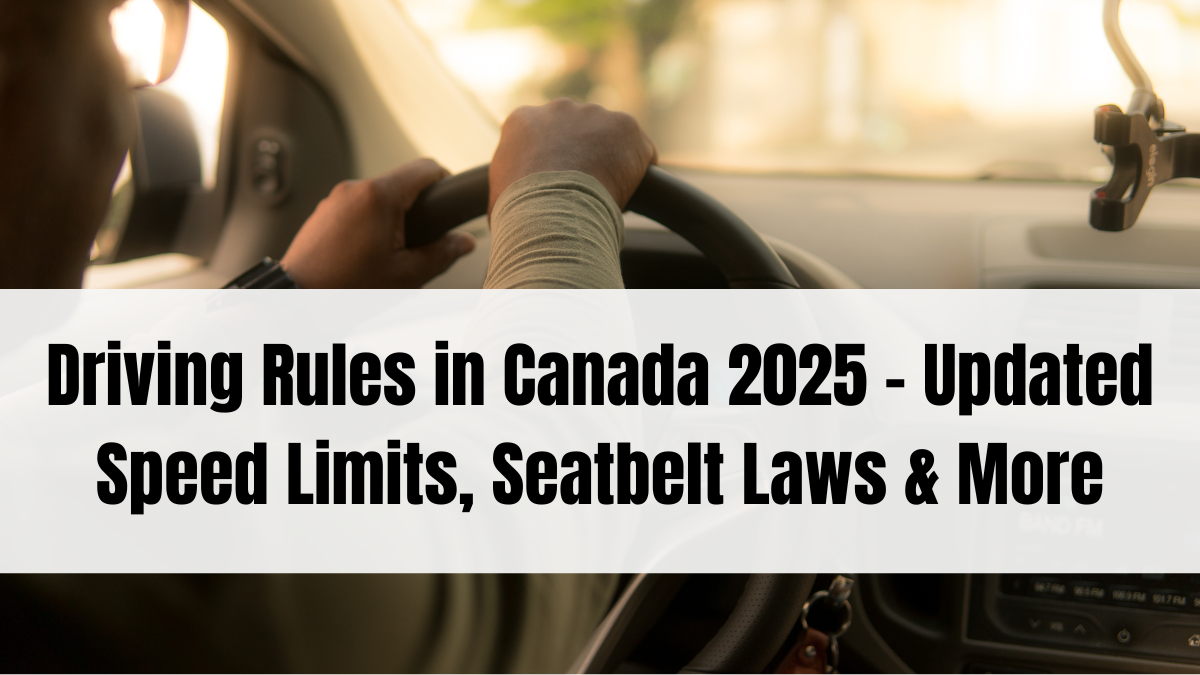Canada’s scenic roadways—from the mountains of British Columbia to the plains of Alberta—attract countless international drivers every year. For Indian tourists or new immigrants driving across provinces, understanding the Canada driving rules 2025 is essential for staying safe and compliant with the law.
The Canadian government has refreshed several nationwide traffic regulations this year, with stricter enforcement on speed, seatbelt usage, and impaired driving laws. Here’s everything you need to know before hitting the Canadian roads in 2025.

Major Speed Limit Revisions Across Provinces
Speed limits vary by province but several updates in 2025 have brought more consistency:
-
Urban Areas: 30–50 km/h (especially in school zones and residential neighborhoods)
-
Rural Highways: 80–100 km/h
-
Expressways & Freeways (e.g., Ontario 401): 110 km/h in many provinces
-
Notable Update: British Columbia has reduced rural highway limits in accident-prone areas from 120 to 110 km/h
Always look for posted signs as limits can shift based on weather or road conditions.
Seatbelt Rules Now Stricter Than Ever
Seatbelt use is now strictly enforced across Canada for all occupants, front and rear.
-
Fine Amounts: Range from CAD $200 to $1,000 depending on province
-
Child Safety Laws: Children under 9 or under 40 lbs must be in an approved car seat or booster seat
-
Police Checks: Random roadside checks are conducted especially in Ontario and Quebec
Indian travellers should note: It’s mandatory even for backseat passengers, which differs from Indian norms.
Alcohol and Drug-Impaired Driving Rules
Canada has a zero-tolerance policy on drug and alcohol impairment:
-
Legal BAC (Blood Alcohol Content) Limit: 0.08%, but provinces like Alberta and Ontario impose stricter penalties starting at 0.05%
-
Cannabis Rule: Driving after cannabis use is strictly illegal and tested on roadside
-
Penalties Include:
-
Immediate roadside suspension
-
Impoundment of vehicle
-
Fines of CAD $1,000+
-
Possible deportation for international students or visitors
-
Traffic Signal & Intersection Etiquette
Canadian road culture relies heavily on courtesy and right-of-way at intersections:
-
4-Way Stop Rule: First come, first go
-
Red Light Turns: Right turn on red allowed after a complete stop unless posted otherwise
-
Pedestrian Priority: Always yield to pedestrians at crosswalks or intersections
Understanding these protocols is crucial to avoid confusion and fines.
Differences Indian Drivers Must Know
| Rule Type | India | Canada (2025) |
|---|---|---|
| Driving Side | Left | Right |
| Speed Units | km/h | km/h |
| Honking | Common, even for alerts | Considered rude except in emergencies |
| Right of Way | Often ignored | Strictly followed |
| Overtaking | Either side | Left side only |
| DUI Tolerance | Variable enforcement | Very strict with zero tolerance zones |
Driving License & IDP Requirements for Indian Tourists
Indian visitors must carry an International Driving Permit (IDP) along with their Indian driving license to drive in Canada legally.
-
Rental Car Requirements: Most companies require drivers to be 21+ and present a valid IDP + passport + credit card
-
Province-specific Requirements: Quebec and Ontario are stricter in checking IDPs at traffic stops
-
Duration of Validity: IDP valid for 12 months; driving license must be in English
For long stays (6 months+), you may need to apply for a local Canadian license depending on province.
Tips to Drive Safely in Canada
-
Always keep headlights ON, even during the day in some provinces like Ontario
-
Use winter tires if driving in snowy months—mandatory in British Columbia from October to April
-
Learn the meaning of signs like “No Standing,” “No Parking,” and “Yield”
-
Maintain a 2–3 second distance from the car ahead
-
Roundabouts are becoming common—yield to vehicles already inside
GPS apps like Waze or Google Maps Canada are highly useful for real-time speed alerts and traffic info.
FAQs
Can I drive in Canada with an Indian license?
Only if accompanied by an International Driving Permit (IDP). Both must be presented together to rent a car or during a police check.
Is driving in Canada difficult for Indian travellers?
It’s relatively easy if you understand the road rules, drive on the right, follow posted signs, and avoid aggressive behavior. Canadian driving culture is very courteous.
What happens if I’m caught speeding?
Speeding can lead to on-the-spot fines, license demerit points, or even court appearances depending on how much you exceed the limit.
Are seatbelts mandatory for backseat passengers?
Yes. Unlike in India, rear passengers are legally required to wear seatbelts in all Canadian provinces.
Do Canadian traffic police accept digital license copies?
No. Always carry physical copies of your IDP, passport, and Indian license. Digital or photocopies are not considered valid during traffic stops.
Click here to know more.
